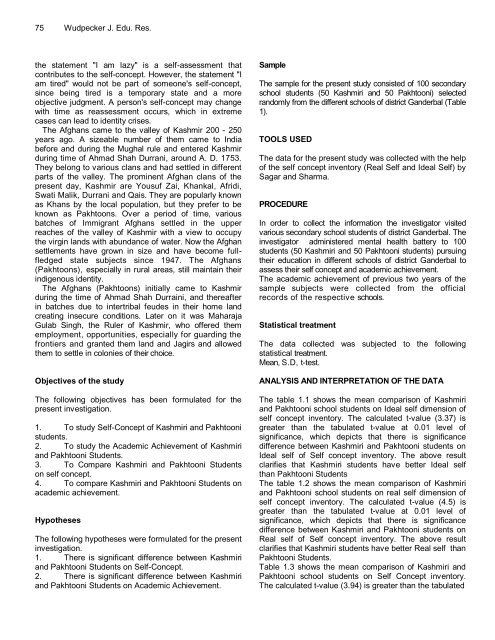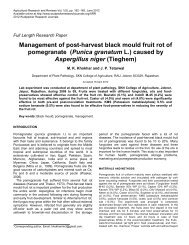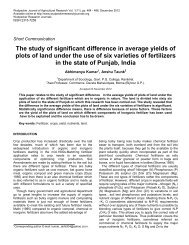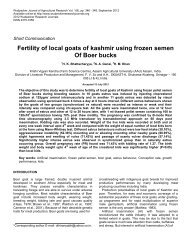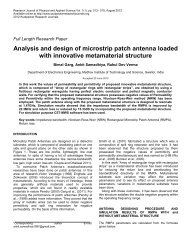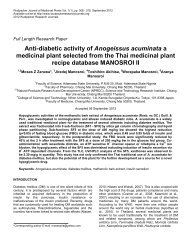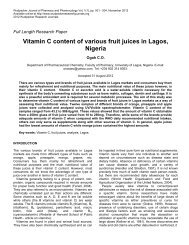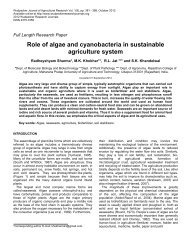Self concept and academic achievement of Kashmiri and Pakthooni ...
Self concept and academic achievement of Kashmiri and Pakthooni ...
Self concept and academic achievement of Kashmiri and Pakthooni ...
You also want an ePaper? Increase the reach of your titles
YUMPU automatically turns print PDFs into web optimized ePapers that Google loves.
75 Wudpecker J. Edu. Res.<br />
the statement "I am lazy" is a self-assessment that<br />
contributes to the self-<strong>concept</strong>. However, the statement "I<br />
am tired" would not be part <strong>of</strong> someone's self-<strong>concept</strong>,<br />
since being tired is a temporary state <strong>and</strong> a more<br />
objective judgment. A person's self-<strong>concept</strong> may change<br />
with time as reassessment occurs, which in extreme<br />
cases can lead to identity crises.<br />
The Afghans came to the valley <strong>of</strong> Kashmir 200 - 250<br />
years ago. A sizeable number <strong>of</strong> them came to India<br />
before <strong>and</strong> during the Mughal rule <strong>and</strong> entered Kashmir<br />
during time <strong>of</strong> Ahmad Shah Durrani, around A. D. 1753.<br />
They belong to various clans <strong>and</strong> had settled in different<br />
parts <strong>of</strong> the valley. The prominent Afghan clans <strong>of</strong> the<br />
present day, Kashmir are Yousuf Zai, Khankal, Afridi,<br />
Swati Malik, Durrani <strong>and</strong> Qais. They are popularly known<br />
as Khans by the local population, but they prefer to be<br />
known as Pakhtoons. Over a period <strong>of</strong> time, various<br />
batches <strong>of</strong> Immigrant Afghans settled in the upper<br />
reaches <strong>of</strong> the valley <strong>of</strong> Kashmir with a view to occupy<br />
the virgin l<strong>and</strong>s with abundance <strong>of</strong> water. Now the Afghan<br />
settlements have grown in size <strong>and</strong> have become fullfledged<br />
state subjects since 1947. The Afghans<br />
(Pakhtoons), especially in rural areas, still maintain their<br />
indigenous identity.<br />
The Afghans (Pakhtoons) initially came to Kashmir<br />
during the time <strong>of</strong> Ahmad Shah Durraini, <strong>and</strong> thereafter<br />
in batches due to intertribal feudes in their home l<strong>and</strong><br />
creating insecure conditions. Later on it was Maharaja<br />
Gulab Singh, the Ruler <strong>of</strong> Kashmir, who <strong>of</strong>fered them<br />
employment, opportunities, especially for guarding the<br />
frontiers <strong>and</strong> granted them l<strong>and</strong> <strong>and</strong> Jagirs <strong>and</strong> allowed<br />
them to settle in colonies <strong>of</strong> their choice.<br />
Objectives <strong>of</strong> the study<br />
The following objectives has been formulated for the<br />
present investigation.<br />
1. To study <strong>Self</strong>-Concept <strong>of</strong> <strong>Kashmiri</strong> <strong>and</strong> Pakhtooni<br />
students.<br />
2. To study the Academic Achievement <strong>of</strong> <strong>Kashmiri</strong><br />
<strong>and</strong> Pakhtooni Students.<br />
3. To Compare <strong>Kashmiri</strong> <strong>and</strong> Pakhtooni Students<br />
on self <strong>concept</strong>.<br />
4. To compare <strong>Kashmiri</strong> <strong>and</strong> Pakhtooni Students on<br />
<strong>academic</strong> <strong>achievement</strong>.<br />
Hypotheses<br />
The following hypotheses were formulated for the present<br />
investigation.<br />
1. There is significant difference between <strong>Kashmiri</strong><br />
<strong>and</strong> Pakhtooni Students on <strong>Self</strong>-Concept.<br />
2. There is significant difference between <strong>Kashmiri</strong><br />
<strong>and</strong> Pakhtooni Students on Academic Achievement.<br />
Sample<br />
The sample for the present study consisted <strong>of</strong> 100 secondary<br />
school students (50 <strong>Kashmiri</strong> <strong>and</strong> 50 Pakhtooni) selected<br />
r<strong>and</strong>omly from the different schools <strong>of</strong> district G<strong>and</strong>erbal (Table<br />
1).<br />
TOOLS USED<br />
The data for the present study was collected with the help<br />
<strong>of</strong> the self <strong>concept</strong> inventory (Real <strong>Self</strong> <strong>and</strong> Ideal <strong>Self</strong>) by<br />
Sagar <strong>and</strong> Sharma.<br />
PROCEDURE<br />
In order to collect the information the investigator visited<br />
various secondary school students <strong>of</strong> district G<strong>and</strong>erbal. The<br />
investigator administered mental health battery to 100<br />
students (50 <strong>Kashmiri</strong> <strong>and</strong> 50 Pakhtooni students) pursuing<br />
their education in different schools <strong>of</strong> district G<strong>and</strong>erbal to<br />
assess their self <strong>concept</strong> <strong>and</strong> <strong>academic</strong> <strong>achievement</strong>.<br />
The <strong>academic</strong> <strong>achievement</strong> <strong>of</strong> previous two years <strong>of</strong> the<br />
sample subjects were collected from the <strong>of</strong>ficial<br />
records <strong>of</strong> the respective schools.<br />
Statistical treatment<br />
The data collected was subjected to the following<br />
statistical treatment.<br />
Mean, S.D, t-test.<br />
ANALYSIS AND INTERPRETATION OF THE DATA<br />
The table 1.1 shows the mean comparison <strong>of</strong> <strong>Kashmiri</strong><br />
<strong>and</strong> Pakhtooni school students on Ideal self dimension <strong>of</strong><br />
self <strong>concept</strong> inventory. The calculated t-value (3.37) is<br />
greater than the tabulated t-value at 0.01 level <strong>of</strong><br />
significance, which depicts that there is significance<br />
difference between <strong>Kashmiri</strong> <strong>and</strong> Pakhtooni students on<br />
Ideal self <strong>of</strong> <strong>Self</strong> <strong>concept</strong> inventory. The above result<br />
clarifies that <strong>Kashmiri</strong> students have better Ideal self<br />
than Pakhtooni Students<br />
The table 1.2 shows the mean comparison <strong>of</strong> <strong>Kashmiri</strong><br />
<strong>and</strong> Pakhtooni school students on real self dimension <strong>of</strong><br />
self <strong>concept</strong> inventory. The calculated t-value (4.5) is<br />
greater than the tabulated t-value at 0.01 level <strong>of</strong><br />
significance, which depicts that there is significance<br />
difference between <strong>Kashmiri</strong> <strong>and</strong> Pakhtooni students on<br />
Real self <strong>of</strong> <strong>Self</strong> <strong>concept</strong> inventory. The above result<br />
clarifies that <strong>Kashmiri</strong> students have better Real self than<br />
Pakhtooni Students.<br />
Table 1.3 shows the mean comparison <strong>of</strong> <strong>Kashmiri</strong> <strong>and</strong><br />
Pakhtooni school students on <strong>Self</strong> Concept inventory.<br />
The calculated t-value (3.94) is greater than the tabulated


